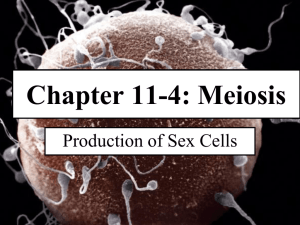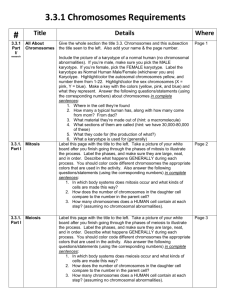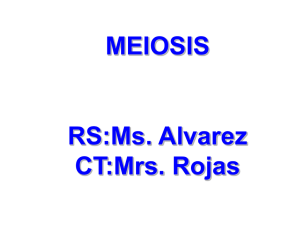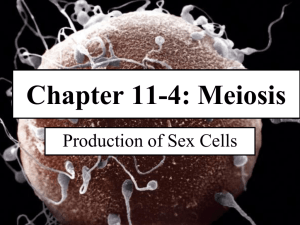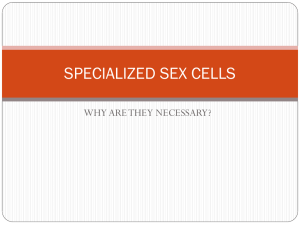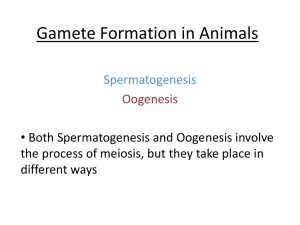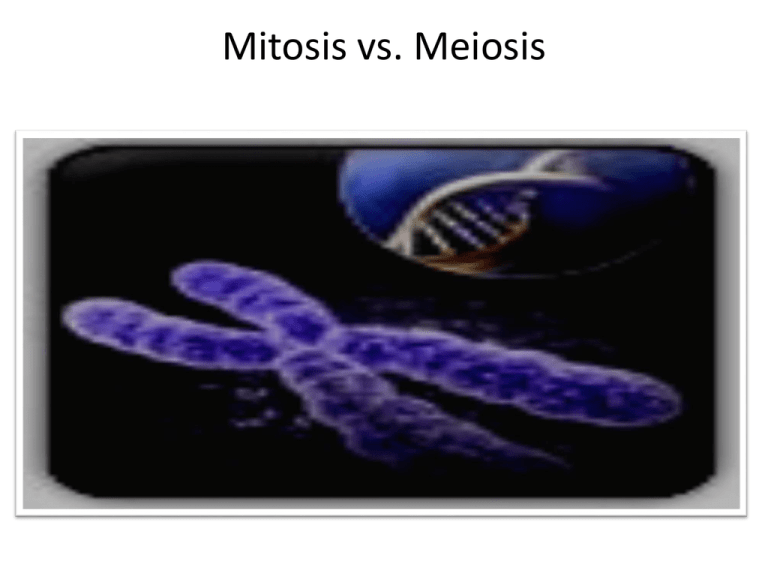
Mitosis vs. Meiosis
Diploid Number of Chromosomes
• In eukaryotes, such as us, a cell has two sets of
chromosomes. In sexually reproducing organisms,
one of these sets was inherited from each of the
parents. Any cell that has two sets of chromosomes
is said to be a diploid cell. A diploid cell has a 2N
number of chromosomes, where N equals the
number of chromosomes in the cells of that
species.
• In human cells that have 46 chromosomes, N = 23.
• All of our somatic cells are diploid.
Diploid vs. Haploid
Sperm & Eggs
• The only exception to this occurs during the
production of gametes (sperm or
eggs). Before fertilization can take place, the
number of chromosomes must be reduced to
half their normal number. This is the N#,
otherwise referred to as Haploid.
• Why does this occur? Because otherwise the
number of chromosomes would double in the
cells of each new generation of individuals!
• Sperm and eggs are gamete cells, which are
haploid.
Meiosis
• Mature sperm and eggs are haploid cells (1N)
that have half the normal number of
chromosomes.
• The union of sperm and egg then creates a
new fertilized egg cell (zygote) that has the
diploid number of chromosomes.
• All cell divisions after fertilization are mitotic
divisions
• The process that creates haploid cells is called
meiosis.
Mitosis vs. Meiosis
• The process that creates haploid cells is called
meiosis.
• The process that creates diploid cells is called
mitosis
• A comparison of mitosis and meiosis can be
seen in the next slide.
Mitosis
Meiosis
Genetic Variation
• There are four main sources of variability in
sexually reproducing organisms. Three of these
occur during meiosis and are as follows:
• 1) the independent assortment of chromosomes
during metaphase I
• 2) the presence of different information on the
two chromosomes of a homologous pair
• 3) crossing over to create new gene
combinations.
• The fourth source of genetic variation is
mutation. This will be covered in a later lesson.
Genetic Errors
• Life is not perfect.
• Sometimes a
chromosomal
separation during
meiosis doesn’t go right
and errors result .
• This can be a simple
source of genetic
variety.
• But this can also present
major problems.
• Chromosomal
aberrations may be fatal
to a developing embryo
or may lead to profound
physical or mental
problems.
Karyotype
• A karyotype can identify chromosomal
aberrations. This is a photographic record of
an individual’s chromosomes. After
photographing the metaphase chromosomes,
the individual chromosome images are cut out
and matched up by homologous pairs. The
resulting karyotype should show 22 pair of
autosomes and 2 sex chromosomes (X or
Y). This procedure can be seen below:
Karyotype
Amniocentesis &
Chorionic Villi Sampling
• In older women or women determined to be
at high risk for conceiving babies with genetic
abnormalities, procedures called
Amniocentesis and Chorionic Villi Sampling
can be conducted to get the karyotype of the
developing fetus. Thus chromosomal
abnormalities can be determined early in
development.
Amniocentesis & CVS
Down’s Syndrome
• Extra or absent autosomes often lead to
spontaneous abortion of the fetus. Some
defects, however, are not as life-threatening
and the fetus survives. One such condition is
trisomy 21 (Down’s syndrome).
• Note that the karyotype will show an extra
chromosome # 21. Nondisjunction or a failure
of daughter chromosomes to separate during
meiosis can cause this to occur. (see the next
slide)
Trisomy of Chromosome # 21
Turner and Klinefelter Syndromes
• There can also be abnormal numbers of sex
chromosomes, however these don’t affect the
survival of the individual. In some cases they
may cause infertility or interfere with the
development of secondary sexual
characteristics. The frequency of some of
these abnormalities is shown in the next
slide. Note that several of these conditions,
such as XYY, have no known effect on the
individual.
Chromosomal Mutations
• Remember, anything that changes the
structure of a chromosome can lead to birth
defects or cancer. Besides adding or deleting
entire chromosomes, there can be deletions,
duplications, or inversion of parts of the
message. These changes may not be seen in
the karyotype of a fetus, but will certainly
alter how the genetic message is read and
interpreted.


